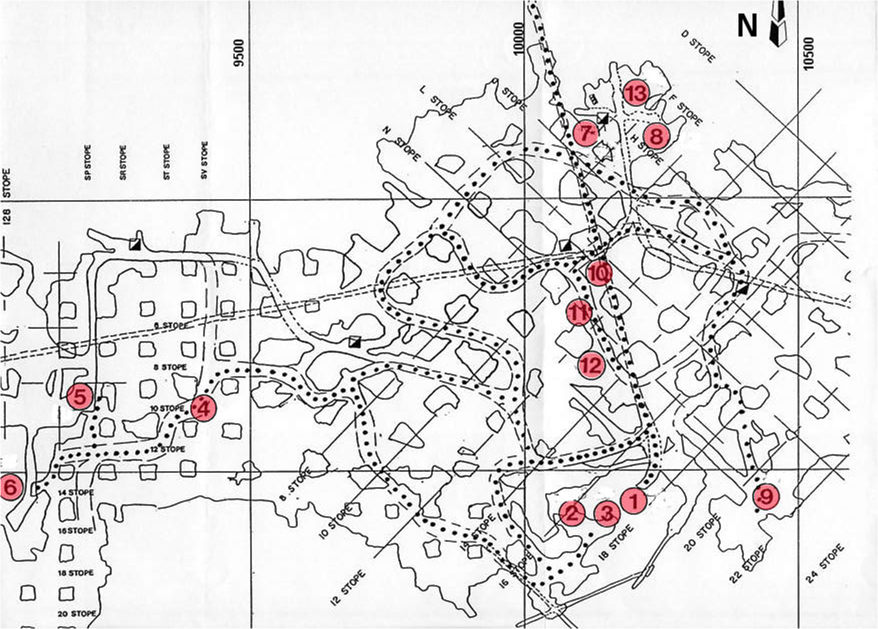| Stop |
Location |
Zone |
|
| Number |
Stope (floor) |
Number |
Geologic Feature |
|
| 1 |
12/14-SRR (190) |
8 |
High grade pollucite core of the Pollucite Zone. |
| 2 |
16-SNN/SPP (184) |
5/8 |
Low Grade Pollucite: a mixture of Pollucite Zone and
Upper Intermediate (Spodumene) Zone.
|
| 3 |
16-SNN/SPP (184) |
5 |
Upper Intermediate Zone - Spodumene-Quartz lntergrowth
(SQUI) after primary petalite .
|
| 4 |
11-SU (190) |
5 |
An approximately 10 metre "Tancocrystic" K-feldspar
crystal in the Upper Intermediate Zone.
|
| 5 |
9-SP/SQ (190) |
5 |
A single petalite pseudomorph; also amblygonite, petalite
and pollucite found in the area.
|
| 6 |
14-SM (190) |
9 |
The Upper Southwest Zone Lepidolite Zone |
| 7 |
7-H (330) |
7 & 3 |
Typical Quartz Zone. Contact with the Saccharoidal Albite
Zone can be observed. The only known location at Tanco where
cleaveable quartz can be seen in situ.
|
| 8 |
10-H (330) |
2 |
Typical Wall Zone displaying megacrystic K-feldspar
crystals.
|
| 9 |
21-N (305) |
6 |
Central Intermediate Zone: the lower portion of a tantalum
zone (O-Zone) in close proximity to a Quartz Zone.
|
| 10 |
|
|
The "Lookout" A good view of room and pillar mining
method. |
| 11 |
12-N (330) |
4 |
Banded aplite in the Lower Intermediate Zone in close
proximity to the Central Intermediate Zone.
|
| 12 |
14-N (350) |
2 |
"Hayward's Horse": A xenolith of host metagabbro
(amphibolite) within Zone 20. Such xenoliths generally
generate their own surrounding Wall Zone (Zone 20)
|
| 13 |
Refuge Room |
4 |
Typical Lower Intermediate Zone showing diverse (1st Level
Stn.) mineralogy (lithian muscovites, SQUI,
cookeite,K-feldspars, Na-feldspar).
|
 Applied Mineral Exploration
Applied Mineral Exploration Discussion and research relevant to mineral
exploration.
Discussion and research relevant to mineral
exploration. 